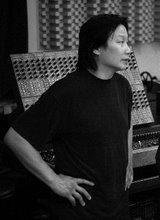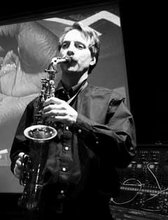American Sound Art on the Italian peninsula
Last summer, I woke up in Carlo Fatigoni ’s countryside home in the hills of Umbria. Over espresso, we asked ourselves, “What if we staged a festival of media and time-based art in Italy?” I also asked “How could I contribute by showcasing North American artists that I have followed, presented and played with in recent years?” Drawing largely on the roster of artists that I presented at GASP Gallery in Brookline, we soon began to formulate the present festival. The result is the Sguardi Sonori festival that premieres this summer in Roma, Benevento, Torino, Venezia and Sienna.
Our exploration of 21st century sonic arts in the United States inevitably led to the work of minimalist composer and intermedia artist Phill Niblock. Now in his 70s, he has led the way for three generations of sonic artists. His use of thick, loud drones, filled with microtonal gestures create a unique omnipresent ambience, much like Giotto’s omnipresent Blue in the Scroveni Chapel in Padova.
Rome is an ideal city to hear the work of electro-diva Pamela Z. Through the use of interactive technologies, Z single handedly creates polyphonic vocal works in real-time, providing a unique opportunity to reflect on the rich traditions of vocal music that blossomed in Rome over the centuries.
Much like Rome, Hollywood fostered an unparalleled community of artists and artisans that collectively built center pieces of culture. For Sguardi Sonori, Los Angeles based composer Gary Chang appropriated the tools of the entertainment industry and repurposed them for use in sonic mediations for the Templar church in San Galgano, Sienna.
Amnon Wolman immigrated to the US from Israel and soon established himself as a protagonist in New York. His investigation of the nature of temporal relations in music led to a series of sound performances and installations that blend artistic wit and scientific inquiry in a mode that is reminiscent of Piero della Francesca.
I first heard Chicago based Olivia Block’s work when I presented her Rhime and Glaze at Berklee College of Music in Boston. This work examined the vast distance between silence and tonality, seemingly retracing the birth of sonic arts. The work did in sound what Luigi Russolo’s Futurist Manifesto did in words.
Europe has long been a haven for the finest artists from the US. Stephen Piccolo and John Duncan developed much of their most important work outside of the mother land, in much the same way as American jazz musicians thrived in Europe in the mid-20th century. Their work is evidence that the uniquely American approach to sonic arts continues to thrive and endure in the 21st century, all over the world.
Neil Leonard
Indianapolis, Indiana
May 2007
Friday, June 1, 2007
Subscribe to:
Post Comments (Atom)


No comments:
Post a Comment